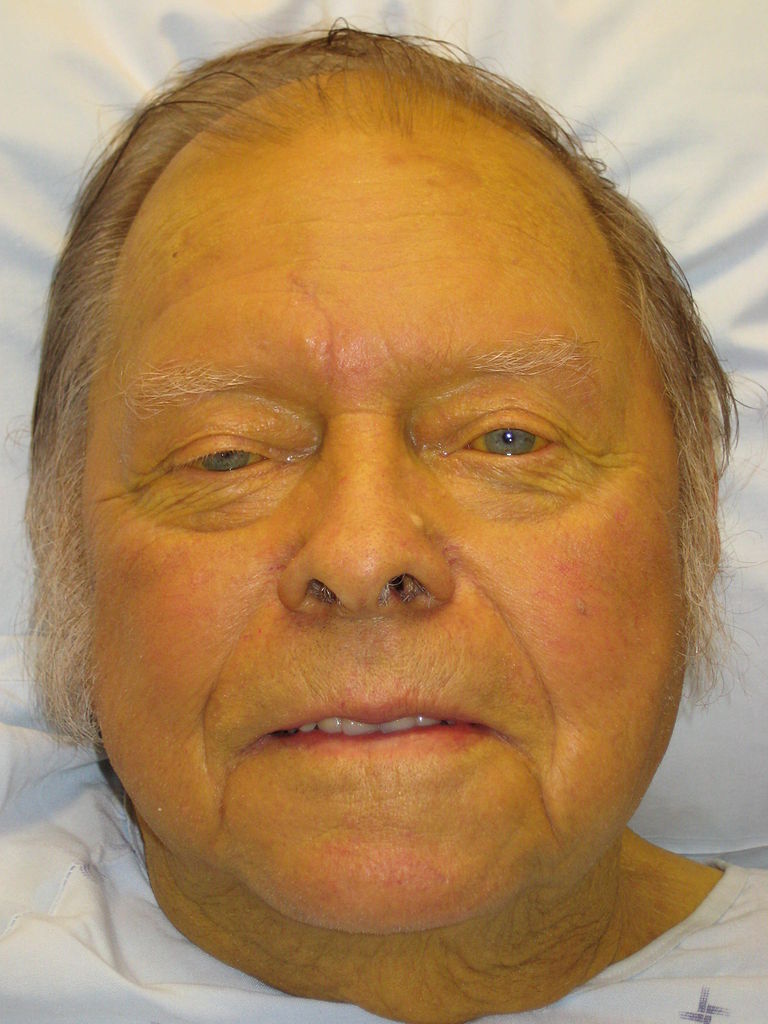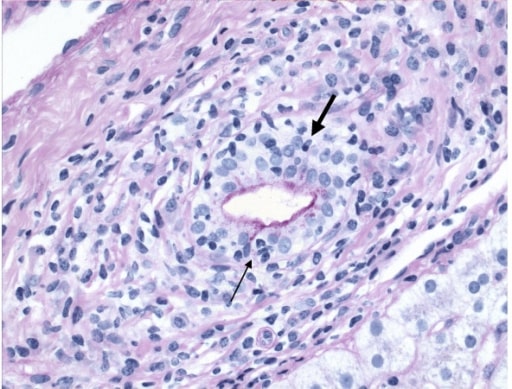Primary biliary cholangitis (PBC) is a chronic disease resulting in autoimmune destruction of the intrahepatic bile ducts. The typical presentation is that of a middle-aged woman with pruritus, fatigue, and right upper quadrant abdominal pain. Elevated liver enzymes and antimitochondrial antibodies (AMAs) establish the diagnosis. Medical management includes ursodeoxycholic acid as the 1st-line treatment and for symptom management. Definitive treatment is liver transplantation, which is performed in late stages (cirrhosis).
Last updated: Mar 4, 2024

Pathophysiology of primary biliary cholangitis (PBC):
A risk factor or trigger may lead to a coordinated T and B cell-mediated response, resulting in biliary epithelial cell (BEC) injury, cholestasis, and fibrosis.
Primary biliary cholangitis Primary Biliary Cholangitis Primary biliary cholangitis (PBC) is a chronic disease resulting in autoimmune destruction of the intrahepatic bile ducts. The typical presentation is that of a middle-aged woman with pruritus, fatigue, and right upper quadrant abdominal pain. Elevated liver enzymes and antimitochondrial antibodies (AMAs) establish the diagnosis. Primary Biliary Cholangitis has a wide range of symptoms. The condition is often asymptomatic in the early phase and features symptoms of decompensated cirrhosis Cirrhosis Cirrhosis is a late stage of hepatic parenchymal necrosis and scarring (fibrosis) most commonly due to hepatitis C infection and alcoholic liver disease. Patients may present with jaundice, ascites, and hepatosplenomegaly. Cirrhosis can also cause complications such as hepatic encephalopathy, portal hypertension, portal vein thrombosis, and hepatorenal syndrome. Cirrhosis in the late phase Late Phase Sepsis in Children.

Jaundice: yellow discoloration of the skin due to bilirubin deposition
Image: “Jaundice08” by James Heilman, MD. License: CC BY 3.0There may be variations in practice based on location. Review detailed recommendations for different regions (US, UK, Europe).
| Stage | Histologic findings |
|---|---|
| Stage 0 | |
| Stage I | |
| Stage II | |
| Stage III | |
| Stage IV |

Primary biliary cirrhosis, demonstrating chronic nonsuppurative destructive cholangitis: Infiltration of lymphocyte (arrow) and plasma cell (bold arrow) into the bile duct is shown.
Image: “Primary biliary cirrhosis” by Department of Medicine, Toronto Western Hospital (University Health Network/University of Toronto), Toronto, Ontario, Canada. License: CC BY 2.0Goals:[6,16]
Pretreatment measures:[6,7]
Specific therapy:
Symptom treatment:
Liver transplantation Liver transplantation The transference of a part of or an entire liver from one human or animal to another. Hepatocellular Carcinoma (HCC) and Liver Metastases:
PBC PBC Primary biliary cholangitis (PBC) is a chronic disease resulting in autoimmune destruction of the intrahepatic bile ducts. The typical presentation is that of a middle-aged woman with pruritus, fatigue, and right upper quadrant abdominal pain. Elevated liver enzymes and antimitochondrial antibodies (AMAs) establish the diagnosis. Primary Biliary Cholangitis/ AIH AIH Autoimmune hepatitis (AIH) is a rare form of chronic liver disease in which the immune system attacks the liver causing inflammation. It predominantly affects women. Clinical presentation ranges from asymptomatic cases to patients that present with symptoms of acute liver failure (jaundice, right upper quadrant pain). Autoimmune Hepatitis overlap:[19]
Follow-up and prognosis Prognosis A prediction of the probable outcome of a disease based on a individual’s condition and the usual course of the disease as seen in similar situations. Non-Hodgkin Lymphomas
Primary biliary cholangitis Primary Biliary Cholangitis Primary biliary cholangitis (PBC) is a chronic disease resulting in autoimmune destruction of the intrahepatic bile ducts. The typical presentation is that of a middle-aged woman with pruritus, fatigue, and right upper quadrant abdominal pain. Elevated liver enzymes and antimitochondrial antibodies (AMAs) establish the diagnosis. Primary Biliary Cholangitis should be differentiated from primary sclerosing cholangitis Primary Sclerosing Cholangitis Primary sclerosing cholangitis (PSC) is an inflammatory disease that causes fibrosis and strictures of the bile ducts. The exact etiology is unknown, but there is a strong association with IBD. Patients typically present with an insidious onset of fatigue, pruritus, and jaundice, which can progress to cirrhosis and complications related to biliary obstruction. Primary Sclerosing Cholangitis ( PSC PSC Primary sclerosing cholangitis (PSC) is an inflammatory disease that causes fibrosis and strictures of the bile ducts. The exact etiology is unknown, but there is a strong association with IBD. Patients typically present with an insidious onset of fatigue, pruritus, and jaundice, which can progress to cirrhosis and complications related to biliary obstruction. Primary Sclerosing Cholangitis), because the 2 conditions have similar presentations.
| PBC PBC Primary biliary cholangitis (PBC) is a chronic disease resulting in autoimmune destruction of the intrahepatic bile ducts. The typical presentation is that of a middle-aged woman with pruritus, fatigue, and right upper quadrant abdominal pain. Elevated liver enzymes and antimitochondrial antibodies (AMAs) establish the diagnosis. Primary Biliary Cholangitis | PSC PSC Primary sclerosing cholangitis (PSC) is an inflammatory disease that causes fibrosis and strictures of the bile ducts. The exact etiology is unknown, but there is a strong association with IBD. Patients typically present with an insidious onset of fatigue, pruritus, and jaundice, which can progress to cirrhosis and complications related to biliary obstruction. Primary Sclerosing Cholangitis |
|---|---|
| Predominantly women | Predominantly men |
| Associated with autoimmune diseases Autoimmune diseases Disorders that are characterized by the production of antibodies that react with host tissues or immune effector cells that are autoreactive to endogenous peptides. Selective IgA Deficiency | Associated with IBD |
| Intrahepatic involvement only | Intra- and extrahepatic involvement |
| Absence of bile Bile An emulsifying agent produced in the liver and secreted into the duodenum. Its composition includes bile acids and salts; cholesterol; and electrolytes. It aids digestion of fats in the duodenum. Gallbladder and Biliary Tract: Anatomy duct narrowing on MRCP MRCP Non-invasive diagnostic technique for visualizing the pancreatic ducts and bile ducts without the use of injected contrast media or x-ray. Mri scans provide excellent sensitivity for duct dilatation, biliary stricture, and intraductal abnormalities. Primary Sclerosing Cholangitis | MRCP MRCP Non-invasive diagnostic technique for visualizing the pancreatic ducts and bile ducts without the use of injected contrast media or x-ray. Mri scans provide excellent sensitivity for duct dilatation, biliary stricture, and intraductal abnormalities. Primary Sclerosing Cholangitis shows narrowing and dilation of bile Bile An emulsifying agent produced in the liver and secreted into the duodenum. Its composition includes bile acids and salts; cholesterol; and electrolytes. It aids digestion of fats in the duodenum. Gallbladder and Biliary Tract: Anatomy ducts. |
| AMA AMA Primary Biliary Cholangitis positive in 95% of cases. |
|